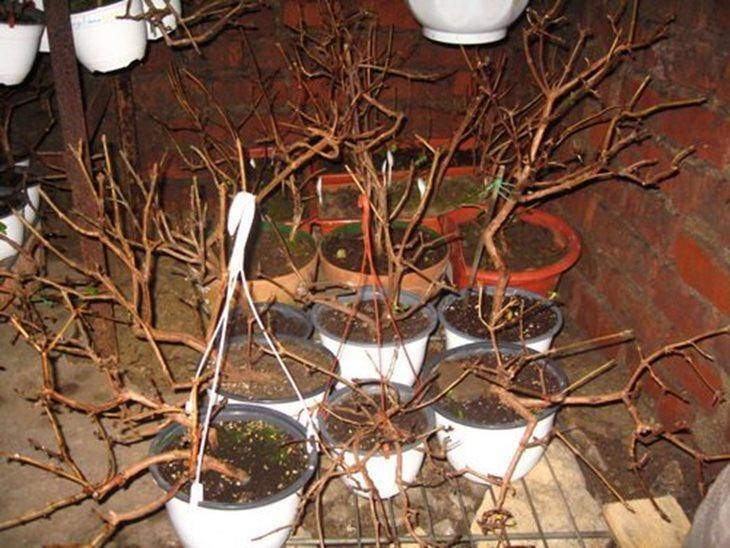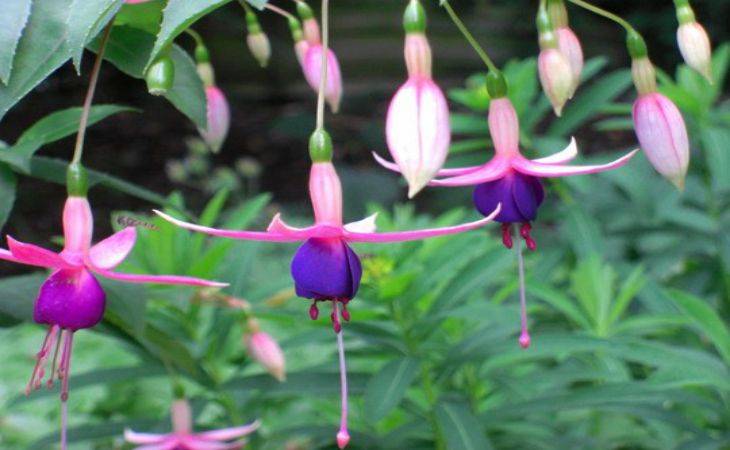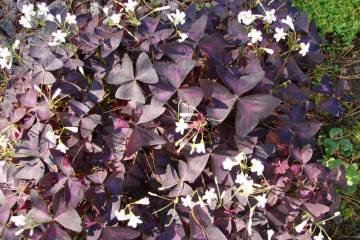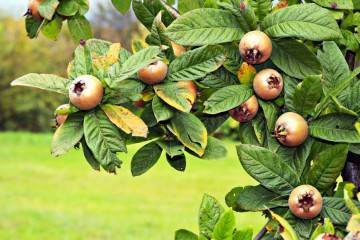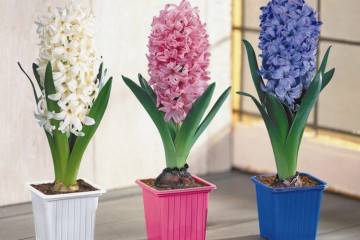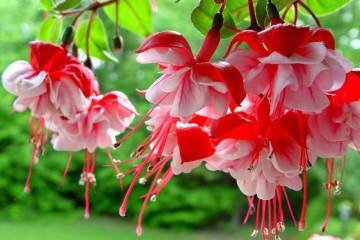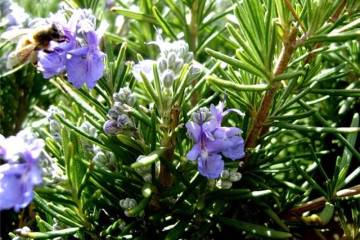Fuchsia street - growing and caring for the garden
Content:
This article will consider a plant such as fuchsia, its cultivation and care in the garden. More than a hundred varieties have been bred over the last century, and now everyone can enjoy its beauty on their own plot or apartment.
What does it look like, which family it belongs to
Fuchsia (Fuchsia) is an evergreen plant with saturated color leaves that have a pointed oval shape and are arranged in pairs. Branches can be either erect or falling. Flowers drooping. The stem is usually light. The plant belongs to the fireweed family.
Charles Plumier is considered the discoverer, it was thanks to him that the world learned about the new plant, whose homeland is New Zealand, South and Central America.
The scientist discovered fuchsia in the West Indies during the next expedition. Since then, the plant has been loved for about 200 years. Fuchsia feels great outdoors and allows you to enjoy its view.
Garden fuchsia is a plant that is grown and tended outdoors. Her bushes are erect, have large flowers, the size of which varies from small to medium. They look great in flowerpots. You can also place fuchsia in a flower pot outside.
This species has the following groups:
- Australian,
- sapphire,
- ampelous,
- terry.
Answering the question, fuchsia is an annual or perennial plant, experts will say: in general, a perennial flower, in its natural environment it grows for more than one year. But in the northern latitudes of Russia, the exotic plant is not ready for wintering outdoors. In such conditions, only some varieties are grown, and in the format of annuals.
But many are interested in the question, can fuchsia be planted in open ground? Some gardeners answer in the affirmative and even give advice on growing fuchsia outdoors and caring for it at different times of the year. More on this will be written later.
Fuchsia: growing and caring for the garden
Fuchsia in the garden in summer feels great. A temperature in the range of 20-25 degrees is suitable for her. As the temperature rises, the leaves may wither and the buds may fall off. Therefore, with strong heat, it is better to send it to the shade so that the lighting is diffused.
Street fuchsia is relatively unpretentious, even a novice amateur will cope with leaving. The main thing is to provide it with protection from direct sunlight, not to plant it on the south side of the site. It will be good if right after noon, the flower bed with fuchsia is in the shade.
At the same time, full shade for the plant is also not suitable, as is the high occurrence of groundwater. If the ground on which the flower grows is too wet or cold, the bush will quickly wither away.
In general, experienced gardeners recommend planting fuchsias in large pots or hanging structures. In this case, the pot with the plant can be rearranged as needed. The planter can even be hung on the veranda, creating a whimsical decor from beautiful flowering plants.
Watering and spraying
Flower lovers are wondering how to water fuchsia at home, when growing in the garden. First of all, you need to focus on the condition of the soil, the ambient temperature and the season. On average, it is worth watering fuchsia at least once every 7 days. However, if the soil is too dry, then watering is allowed once every 3-4 days.
Since the humid tropical climate is native to fuchsia, it will be delighted to be sprayed at least twice a week.
In this case, it is important to use warm, settled water. It is best to collect rainwater and use it. Tap water is not suitable for a flower at all, as it contains chlorine.
Fertilizers
For this flower, regular and timely feeding is very important. In simple garden soil, without fertilizers, the bush will not bloom profusely, its decorative qualities will be low.
The first portion of the substances is introduced before planting. Humus and phosphorus fertilizers are added to the fertile soil.
Further feeding is distributed according to the growth phases:
- At the first stage, at the beginning of summer, fuchsias need complex fertilizers with a high nitrogen content. Such feeding will help the plant to strengthen and build up green mass.
- Before flowering, potassium and phosphorus must be added to the ground so that the bush plant can lay as many buds as possible. This will be the key to colorful and lush bloom.
- To prevent the flower cover from disappearing too quickly, it is better to feed the flower with organic matter. In this case, flowering will be delayed and will delight the gardener longer.
Experts recommend alternating mineral and organic fertilizers, adding one or the other every two weeks.
Winter preparation and further care
In order for the plant to successfully survive the not entirely favorable temperature conditions of the Russian winter, you should start preparing for the cold in advance and know the rules for preserving the flower.
Fuchsia can winter in a loggia, on a veranda, in a greenhouse. It can be placed in a basement or in a trench. If the choice fell on wintering in a room, then it must be transplanted into a container and placed away from the battery.
First of all, you should forget about fertilizers from the beginning of autumn. But in September, you need to trim.
Before transferring fuchsia for storage indoors, you need to inspect it and get rid of the stems and leaves that have dried up. It does not hurt to spray with special preparations to protect against harmful insects and their larvae.
As stated above, growing in pots, flowerpots, and planters has its advantages. With this approach, a flower lover simply at the end of autumn transfers containers with flowers to the basement, where they calmly wait for spring, being at rest.
Outdoor wintering
In the southern regions, wintering of fuchsia in the open field is allowed. A plant can survive under the snow if it is well covered with spruce branches. On top of the spruce branches, you need to spread the film to protect the wintering plant from excess moisture.
On the 15th of May, you need to start removing the film, giving the plant a chance to breathe.
When and how it blooms
With proper care, fuchsia blooms every year. Thanks to the wonderful colors, it even acquired the name "Chinese Lantern". The flowering time depends on the variety.
The flowers are drooping, grow abundantly and for a long time. Depending on the variety, there are both small and large, collected in brushes or scattered singly, terry or not. As for the color, it ranges from a delicate crimson to a bright, rich purple hue.
The shape of the flowers resembles a doll in a ballet tutu. They grow on long stalks.The color may not even be one, but several (up to three).
Flowering in general is quite long:
- The three-leafed bloom from May to October.
- Sparkling - all summer long.
- Graceful, Lying and Waist - March to November.
- Slendens - all year round.
- Thyroid - from July to October.
- Bolivian - the first two months of spring.
Pruning
In order to grow the healthiest plant possible, gardeners usually cut dead leaves on their own by winter in anticipation of new shoots in the spring. Also, you should constantly cut off diseased and broken branches.
Young shoots in the spring are cut by a couple of centimeters if the formation of a lush crown of a bush is expected. This procedure is carried out twice, with an interval of two weeks.
Some amateurs try to form a standard fuchsia by regularly cutting off its lateral shoots. How productive this activity is is hard to say. There are only verbal descriptions of how a small tree was allegedly obtained from a bush. Even photographs of such plants cannot be found.
Fuchsia transplant
It is recommended to transplant during the beginning of the growing season, that is, in the spring.
Before transplanting, you need to inspect the roots for mold. The new pot should have solid walls and ample space.
If we talk about transplanting in the spring from a home pot to a flower bed, then you should wait until the end of May, when the threat of recurrent night frosts has completely passed. Fuchsia is transplanted into the garden along with a lump of earth, using the transshipment method. In the first two weeks, they do not feed, water it moderately, carefully observe how the plant takes root.
How does it multiply
Reproduction by cuttings is considered the most productive.
Since an adult plant is pruned in the fall, the remaining cuttings can be used for propagation. To do this, it is worth selecting the strongest shoots, preparing a cutting up to twenty centimeters in size from them, removing the lower leaves and placing it in water. The roots will soon grow, approximately in a week - this is a sign that you can plant the stalk in a glass.
This is followed by standard care for the first year. Only then can you try to plant the plant in open ground. However, such young fuchsias do not take root well.
Seed propagation is not easy. First of all, because it is difficult to obtain material - for this you need to resort to artificial pollination. In the fall, you will have to collect the seeds and dry them thoroughly.
To properly propagate fuchsia by seeds, then you will have to act like this:
- Get a container with high walls and damp soil.
- Sow seeds.
- Cover it with a glass lid.
- Provide light access for half a day.
The seeds in the soil need to be looked after: the substrate requires constant watering, and the seedlings should be allowed to breathe a couple of times a day for half an hour.
Possible growing problems
Although fuchsia is an unpretentious plant, certain problems can arise with it. To avoid this, you must definitely follow all the recommendations for planting, watering and feeding. The presence of pests or diseases is easily identified by the appearance of fuchsia.
- Red spider mites can spoil the plant by entangling leaves with their cobwebs. To avoid the death of the flower, you need to treat the plant with a special agent - Fufanon insecticide.
- The whitefly can lay eggs and the hatched butterflies will feed on the sap of the plant, killing it slowly.For protection, you need to rinse with soapy water without touching the roots. The special preparation Aktara will be even more effective.
- Standard commercial insecticides also help control caterpillars, aphids, and other pests.
Problems can manifest themselves as due to improper care, for example, excessive or insufficient watering, lack of light or its abundance, as well as due to various fungi.
- If the leaves are covered with brown spots, cut them off immediately and rinse the entire plant with soapy water. If a lot of leaves are affected, then it is better to use Topaz.
- Yellow leaves speak of Chlorosis. In this case, you need to feed the plant with mineral fertilizers with magnesium and nitrogen.
In general, reviews about this plant say that with proper care, problems should not arise.
Fuchsia species
Fuchsia in Russian dachas is of different types:
- Bolivian,
- Magellanic,
- thin,
- lying,
- hybrid,
- graceful, etc.
In the wild, this plant is a perennial. However, in Russian gardens, it turns out to be grown only as an annual. There are certain types for indoor cultivation, which are extremely difficult to take root in the garden. Other varieties can be planted in open ground.
In summer, these varieties will produce large, bright flowers. They are tall, bushy, up to seventy centimeters in height. For the southern regions, Ricarton's fuchsia and perennial garden fuchsia Graceful are suitable - they can withstand a drop in air temperature to zero degrees, so they can well winter in the garden, with good shelter. In this case, the flower lover will not have to carry the flowerpots into the house for the winter.



